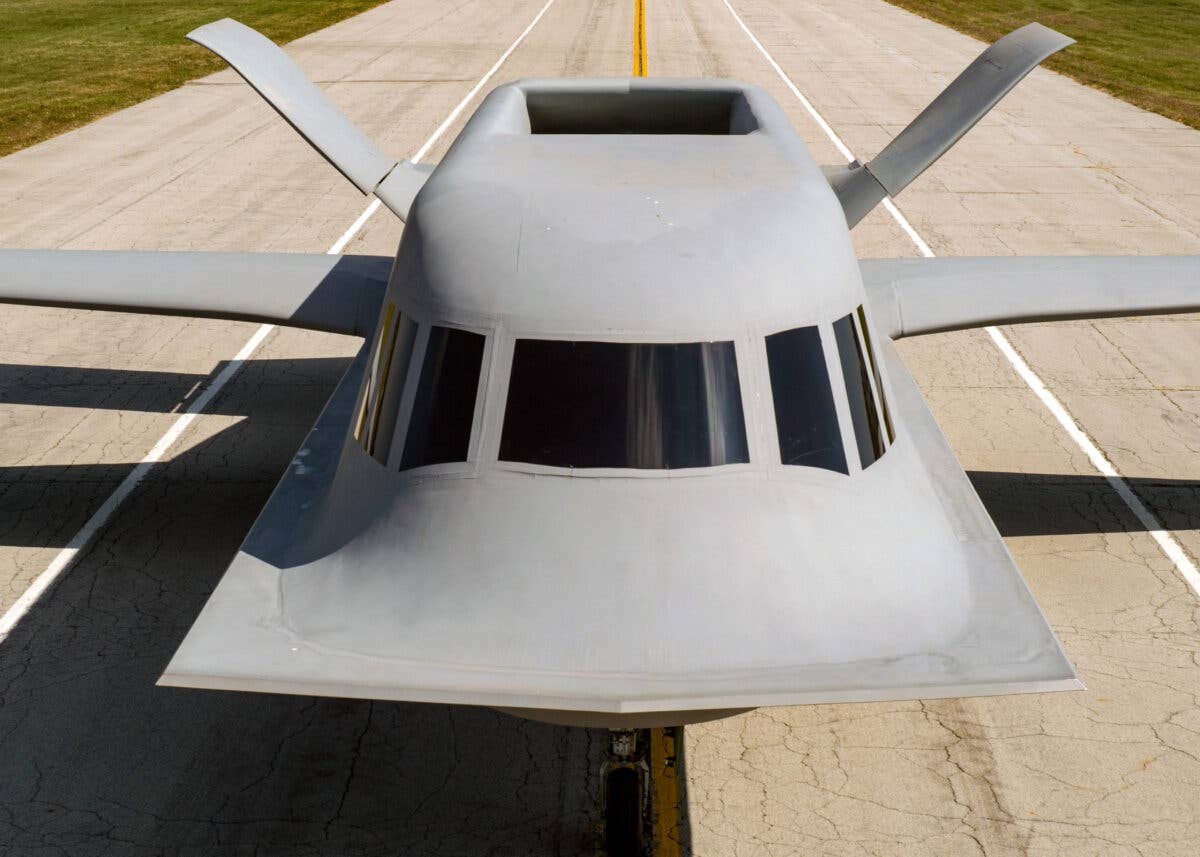Northrop Tacit Blue: Ugly Duckling of Stealth Aircraft
While a Northrop official described the Tacit Blue as one of the most unstable aircraft ever flown, its data aided in the development of several weapon systems.

The ugly duckling of stealth aircraft, the Tacit Blue presented intriguing proportions from any angle. [Courtesy: USAF]
November 1988 was an eventful month in the world of aviation. Within a two-week period, both the Lockheed F-117 Nighthawk and the Northrop B-2 Spirit were first unveiled to the public. This popularized the term “stealth” in the context of aviation, and it became known as a shadowy, top-secret technology that was able to render aircraft virtually invisible to radar.
Fast-forward to April 1996, and another stealth-focused design was unveiled to the public with decidedly less fanfare. One look at the aircraft explained why. Rather than portraying a dark, ominous look, like the preceding two types, the Northrop Tacit Blue battlefield surveillance aircraft furrowed eyebrows and evoked more confusion than awe.
With a widely-spaced V-tail, a bulbous fuselage, and a large chine wrapping around the fuselage and giving it a boxy look from above or below, the Tacit Blue looked more bizarre than intimidating. Despite being engineered for low radar observability, this was not immediately apparent at first glance, and it lacked the matte black color of other stealth aircraft. Those working in the program gave it the nickname “Whale” and “Alien School Bus.”
The unconventional look of the Tacit Blue could be explained by the unique approach and constraints undertaken by the design engineers. They followed two requirements. The first was to create an efficient stealth reconnaissance aircraft that could loiter at low speeds near a battle zone while remaining undetected by the enemy. The second was to design the aircraft around a large side looking array radar (SLAR) with which the crew could provide real-time targeting data to a ground command center.
This was rather opposite from the existing convention. Historically, radar systems had been designed to accommodate an individual aircraft’s space and payload restrictions. But in the case of the Tacit Blue, they designed the aircraft around the radar.
This resulted in a unique airframe shape with odd proportions, and correspondingly unique solutions had to be found to make it flyable. The wing, for example, was just over 48 feet in span and utilized the 1930s-era Clark Y airfoil. An airfoil utilized by the Hawker Hurricane and the Spirit of St Louis, this was chosen in part for its efficient low-speed performance that provided good endurance. The aircraft was naturally unstable, however, so Northrop engineers designed a quadruple-redundant digital fly-by-wire flight control system to remedy this.
Two Garrett ATF3-6 turbofan engines—like those used in the Dassault Falcon 20—were selected to power the Tacit Blue. Unlike the Falcon, however, the engines were buried in the aft fuselage, necessitating the use of a single dorsal intake that fed both engines. This complicated certain operational aspects such as engine starting, but it also provided valuable internal space that could be used to cool the engine exhaust, reduce infrared emission, and help keep the aircraft from being detected by the enemy.
With all four flight control computers operating normally, pilots reported excellent flying and control characteristics. Predictably, these characteristics deteriorated as computers failed or were taken off line. Without any of the flight control computers operating, a Northrop vice president described the Tacit Blue as one of the most unstable aircraft ever flown. An engineer likened the stability with one operating computer to that of the notoriously unstable Wright Flyer.
Over a three-year period, test pilots logged approximately 250 hours in the Tacit Blue, validating both the stealth technology incorporated into the airframe as well as the massive SLAR contained inside. The resulting data aided in the development of several weapon systems, including one that evolved into the E-8 Joint STARS radar system. Additionally, multiple stealth characteristics were incorporated into the B-2 Spirit strategic bomber.
Only one Tacit Blue was built. Today, it remains on display at the National Museum of the U.S. Air Force in Dayton, Ohio.

Sign-up for newsletters & special offers!
Get the latest FLYING stories & special offers delivered directly to your inbox






